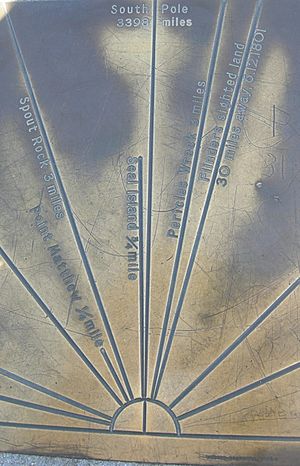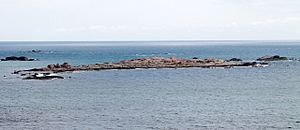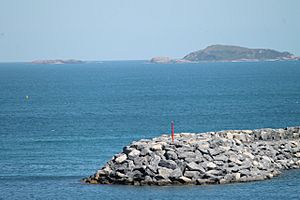St Alouarn Islands facts for kids
The St Alouarn Islands are a group of islands and rocks. You can find them south-east of Cape Leeuwin in Western Australia. They are about 11 kilometers (7 miles) south of Augusta in Flinders Bay. These islands are a special place, especially for birds!
Contents
Discover the St Alouarn Islands
A Peek into History
The islands got their name in 1792. A French explorer named Antoine d'Entrecasteaux named them after Captain Louis de St Alouarn. Captain St Alouarn had sailed in this area in 1772 on his ship, the Le Gros Ventre. He was part of a bigger trip led by Kerguelen.
Where Are These Islands?
You can see the islands from the Point Matthew lookout. This lookout is on the road between Augusta and Cape Leeuwin. There's a special brass compass plate there. It shows you where the islands are and how far away they are.
Shipwrecks and Wildlife
The waters around Cape Leeuwin have seen many ships sink.
Famous Shipwrecks
One well-known shipwreck near the islands is the SS Pericles. This ship sank on March 13, 1910. It hit a rock that wasn't on any map! This happened in daylight, right near the Cape Leeuwin lighthouse.
Home to Amazing Birds
Even though there are shipwrecks, the islands are very important for birds. Many different kinds of birds make their homes here. Seal Island and St Alouarn Island are special nature reserves. They help protect these bird colonies.
Boats that go Whale watching from Augusta Port usually don't go near these islands. They travel around Flinders Bay, to the east of the islands, to see the whales.
Meet the Islands and Rocks
Here are some of the main islands and rocks in the group, listed by how far they are from the mainland:
Seal Island: A Flat Rock Haven
- Seal Island (Augusta, Western Australia) is a large, flat, brownish rock. It's about 1.5 kilometers (1 mile) south of Point Matthew.
- It might have been named by George Vancouver in 1791.
- Seal Island is a Nature Reserve. It's about 4 hectares (10 acres) in size. This reserve helps protect the animals living there.
Saint Alouarn Island: A Special Reserve
- Saint Alouarn Island 34°24′15″S 115°11′30″E / 34.40417°S 115.19167°E is about 5.5 kilometers (3.4 miles) south-east of Point Matthew.
- It became a special "A class reserve" in May 1960.
- Later, it was named a Wildlife Sanctuary in December 1972.
- In May 1979, it officially became a Nature Reserve.
- Saint Alouarn Island Nature Reserve is about 8.5 hectares (21 acres) big. It's also a reserve for protecting animals.
Flinders Island: Named on Old Maps
- Flinders Islet (also called Flinders Island) 34°21′00″S 115°20′00″E / 34.35000°S 115.33333°E is about 7 kilometers (4.3 miles) south-east of Point Matthew.
- It was named on an old map called Admiralty Chart 1037 in 1878.
- In 1986, Flinders Island and other rocks south of Augusta became an "A" reserve.
- It is also part of a special protected area called the Ngari Capes Marine Park.
Other Named Rocks
There are a few other named rocks in this island group:
- Square Rock is 7.5 kilometers (4.7 miles) south-east of Point Matthew.
- South-West Breaker is about 9 kilometers (5.6 miles) south-southwest of Point Matthew. It's the farthest named rock from the mainland.
There are also many unnamed rocks. They run in a line between Cape Leeuwin and South-West Breaker. One exception is Spout Rock, which is west of Flinders Islet.
Augusta's Port: A Gateway to the Sea
In 2009, the area for the Augusta Port was officially set. It included the northernmost point of Saint Alouarn Island, Seal Island, and Point Matthew.
From 2013 to 2014, the Western Australian government built a new harbor. This new port is outside the Hardy Inlet area, near the Blackwood River mouth.
The port is located south of the Flinders Bay settlement and boat ramp. You can see it from there. It's also right next to the road that leads to the Cape Leeuwin lighthouse.
Before this new port, large ships would anchor in Flinders Bay. They also used the Flinders Bay jetty. But that jetty only worked for a short time, from the 1890s to the 1930s. After that, Flinders Bay didn't have a proper port for a long time.





